
Regina Luz Jordan, founder of at Hollywoodland News, had the chance to speak with Sharen Davis and she shared with us her journey, her triumphs and how she has stories woven into every stitch.
On Juneteenth, inside the Academy Museum, Hollywoodland News had the honor of joining an intimate conversation with the woman who brought Ray, Dreamgirls, The Help, Django Unchained, and so many others to life through costume design.
This wasn’t just a Q&A. It was a moment of truth. An exclusive with one of the most important voices in Hollywood’s design history. A Black woman who didn’t just break through the system, she stitched a new standard into the seams.
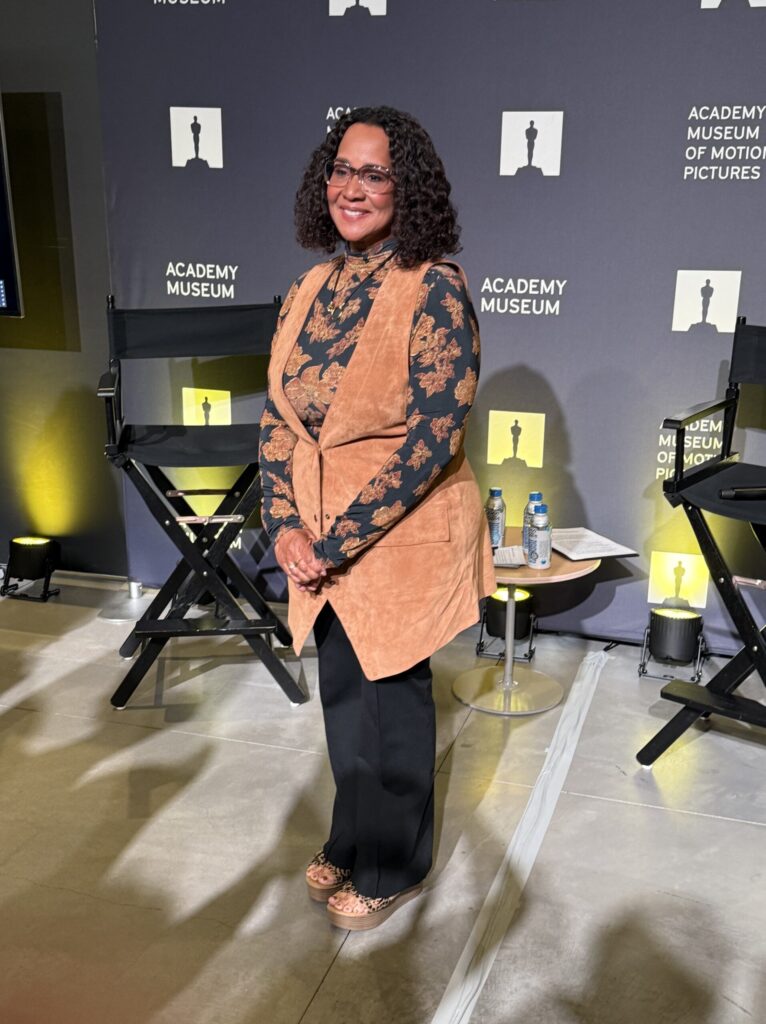
Sharen Davis doesn’t just design costumes. She preserves memory. She shapes legacy. She tells stories that have been stolen, silenced, or flattened into caricature. And she does it with the kind of grace and power that makes you sit up straighter and rethink everything you thought you knew about what costume design actually means.

She talked about her early years as a sensitive child, making fashion shows for her siblings. About Tokyo, San Francisco, Disney, and the unexpected job that led to a career. She talked about Denzel, Jamie, Viola, and Beyoncé.
She talked about domestic workers, Tarantino and spaghetti westerns, church dresses and powder blue silk, and how every look carries something more than fabric. It carries weight. It carries memory. It carries pride. Getting to ask her a question about historical accuracy and the responsibility of telling Black stories through a costume lens wasn’t just special. It was powerful. It was everything this platform is about.
This was a moment for the record books. And we got to be there.
From Sketch Pads to Soundstages:
How Sharen Davis Found Her Way In
Before Sharen Davis dressed some of the most iconic characters in modern cinema, she was a quiet kid sketching out her own world. She didn’t set out to be a costume designer but she wanted to be an actress and pursued that.
Like so many women who carve out space where none was offered, Sharen made a way.

“I was a quite sensitive child and I took solace in doing fashion shows and patrol balls with my brothers and sisters,” she said, remembering her early years. “I took classes in sketching and read a lot… in my pre-teen and teen years I lived in Tokyo and Tokyo opened up amazing opportunities.”
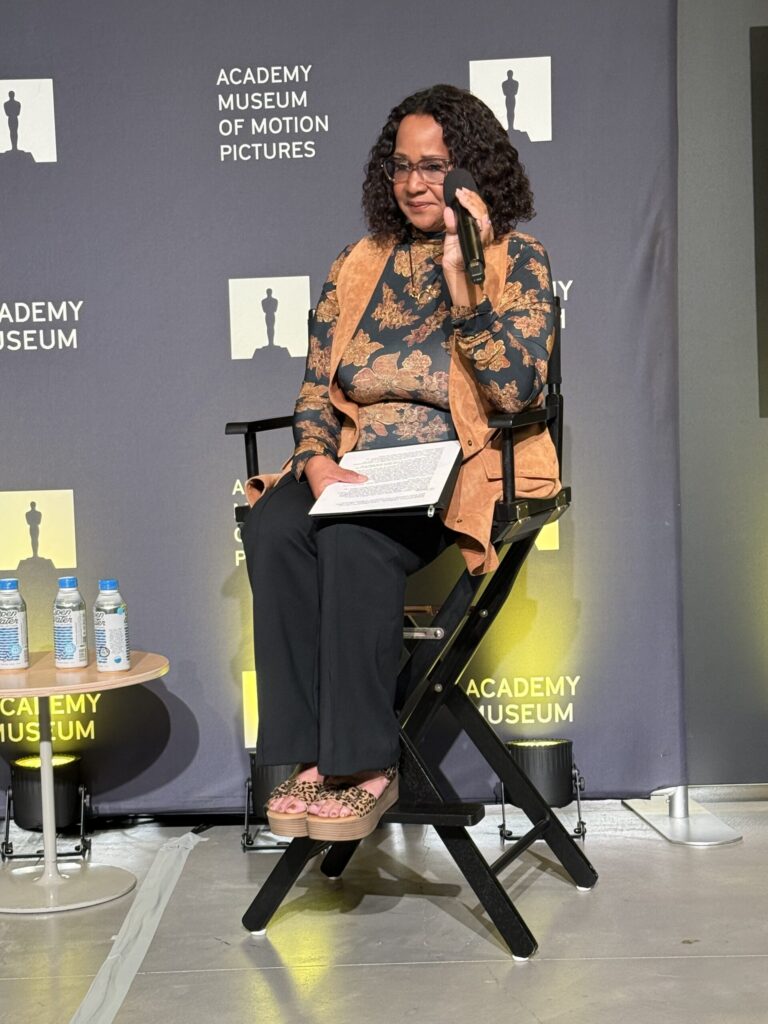
It was never linear. Her father was in the Air Force so she learned how to adapt early. One day she was performing in commercials in Tokyo and the next she was back in California, enrolled in theater programs that taught her to do a little of everything. That’s when she first met Denzel Washington. Neither of them could have guessed it then, but their paths would keep crossing.
“I went to a theater program called Pacific Conservatory of Performing Arts in central California,” she said. “They encouraged you to participate in every aspect of theater… and it just happened that Denzel Washington was an artist in residence there. That was the first time our paths crossed.”
From there, she did what so many struggling artists do. She moved to Los Angeles, lived with roommates, and took whatever job would pay the bills. A friend got her a gig in a costume shop and though she didn’t know it yet, she was about to fall into the thing that would change her life.
“Somehow I landed an interview for a film to be a costume supervisor,” Sharen recalled. “I was like, what’s that? But it was a lot of paperwork. I really enjoyed the puzzle of it all.”
It was an intersection of logistics, creativity and character and that became the foundation of her career. Her early work included walkaround costumes for Disney and building parade pieces that never saw the light of day. But none of it was wasted. Each role, each sketch, each stitch led her closer to the moment where a director would finally look at her and say, “You’re the costume designer.”
That’s when the real journey began.
Costuming Black Legacy: Pride, Memory and the Power of Representation
Sharen Davis isn’t just designing for the screen. She’s protecting something bigger. Her work tells stories that haven’t always been allowed to exist in Hollywood, stories about Black joy, struggle, survival and style. From Ray to Dreamgirls to The Help, Sharen has been behind the scenes making sure that what we see is rooted in truth.

“Even at the beginning, when I said yes to everything offered, I felt an emotional connection to the material,” she said. “Based on Black struggles, freedom from enslavement, a young Black girl breaking barriers in spelling bees, a Black unhoused man with his son working as an intern. I just really connected to the Black experience in the films.”
That connection wasn’t just intellectual. It was deeply personal. When The Help landed on her desk.
“My grandmother was a domestic at the time, still in Louisiana, and I just felt like I needed to take this project for her,” she said. “I needed to protect her image.”
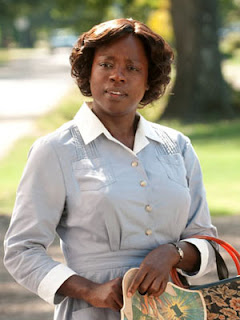
So she worked from memory. Viola Davis became her grandmother on screen. Octavia Spencer’s character was shaped by the sass and confidence of her aunt.
She didn’t just recreate history. She filled in the gaps that Hollywood had ignored.
“Viola was more or less my grandmother,” she said. “My grandmother was always proud and very neat… never embarrassed or bright, always just very tailored. Octavia was more of that character who always dressed in tits no matter when she went out.”
You can feel that pride in everything she does. In Ray, Sharen and her team created over 100 looks for Jamie Foxx. She visited Ray Charles in person, studied his Braille-labeled closet and filled two full research binders with every detail.
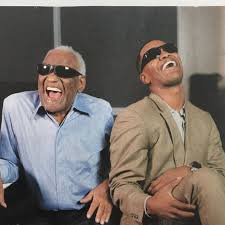
“All the Braille was in his clothes. The colors and the suits down to the socks. It was incredible,” she said. “When you hear Ray’s music, you just relax. You get excited that you’re doing this project.”
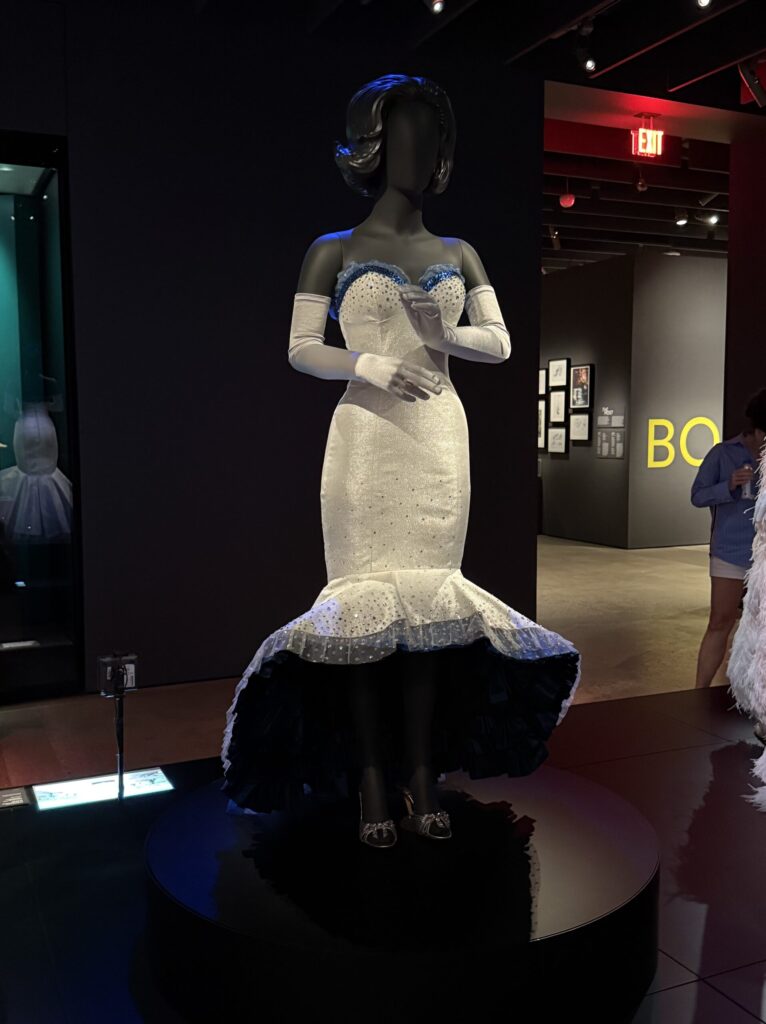
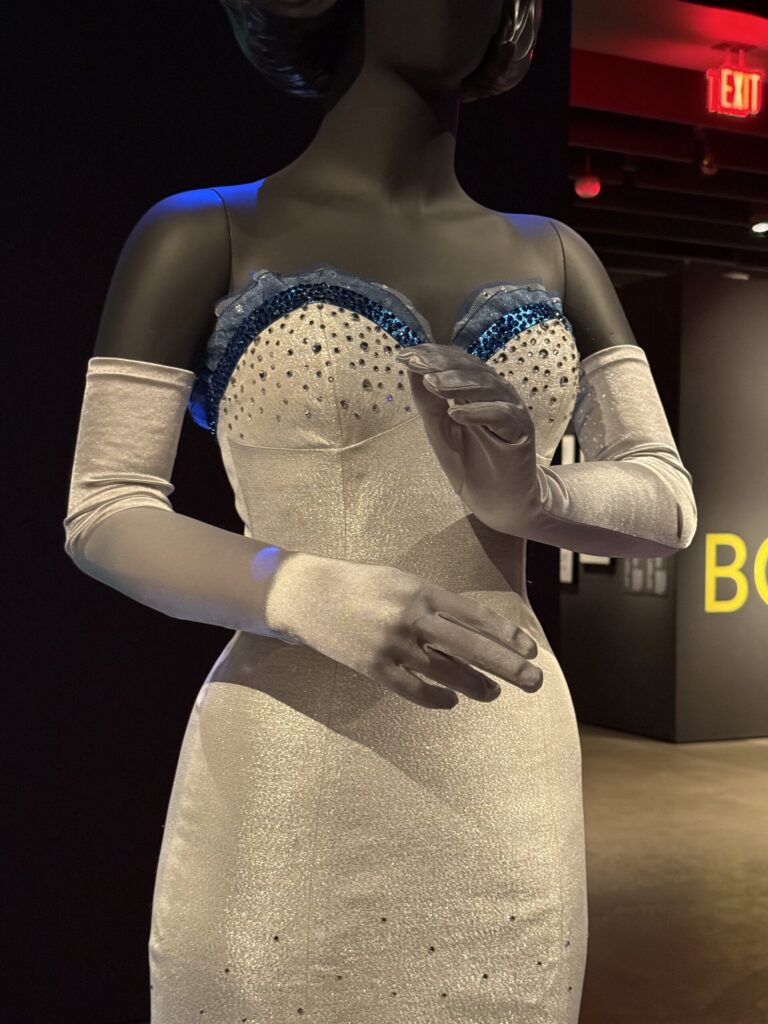
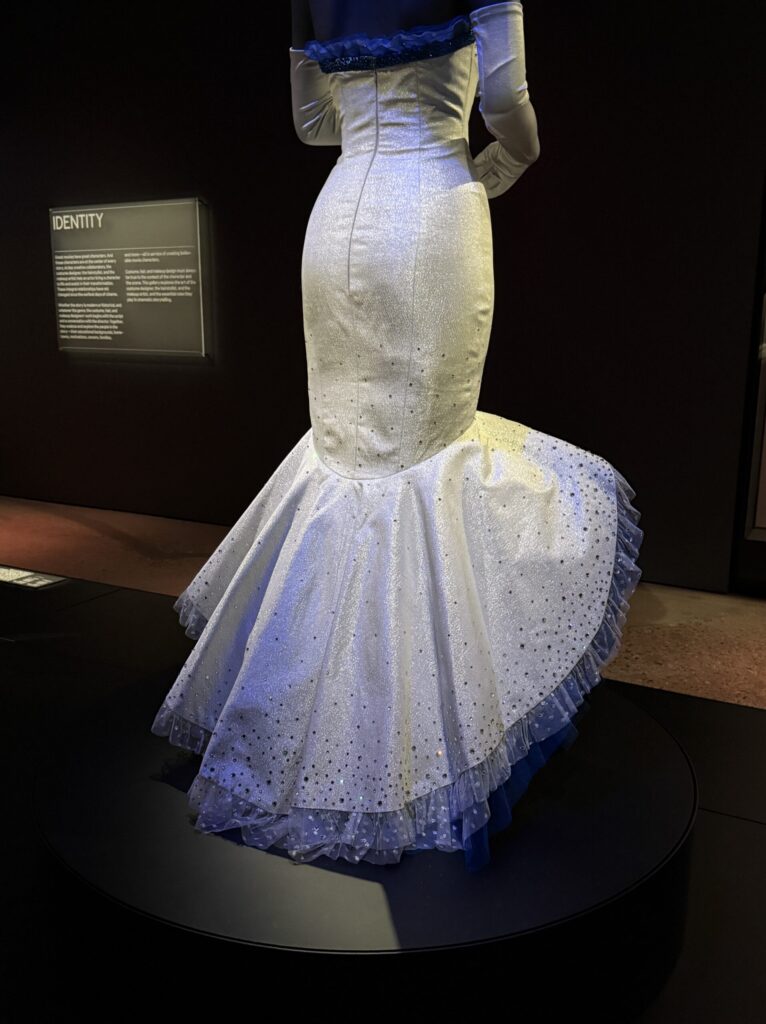
Then came Dreamgirls. Where Ray was rooted in realism, Dreamgirls was a fashion fantasy, full of movement, glam and three women with completely different body types who had to look like a unified group.
“All the shoes had to be custom made,” she said. “They all had extremely different body types and I would have to look at six or seven different dress styles before I found one that looked good on all of them.”

Beyoncé, she said, could wear anything. Jennifer Hudson was newer, so she made sure the clothes supported her vocally and emotionally.
Sharen wasn’t just styling…
She was nurturing, protecting and elevating, all while jumping between Dreamgirls and The Pursuit of Happyness, which she was designing at the same time.
The range in those projects is massive. But the intention stays the same. Sharen Davis designs from memory, love and experience. She doesn’t just put Black stories on screen. She honors them.
Period Pieces and Power: Designing Across Time with Intention
Sharen Davis doesn’t just recreate history. She bends it into something sharper. Something more alive. Her period work goes beyond aesthetic. It’s about showing Black lives in full color and with agency, complexity and truth.
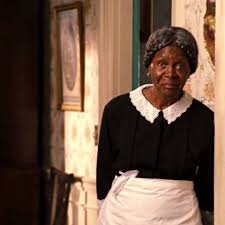
Whether it’s a Depression-era thriller like Devil in a Blue Dress or a blood-soaked fantasy like Django Unchained, Davis steps into every decade with intention. And she brings her characters with her.
“When I get the script, I start living the script,” she said. “Even if I don’t take the project, I try to put myself into it. If I can’t, then I don’t really want to do it. Because I won’t be giving the director 100 percent and I won’t be giving the talent 100 percent either.”
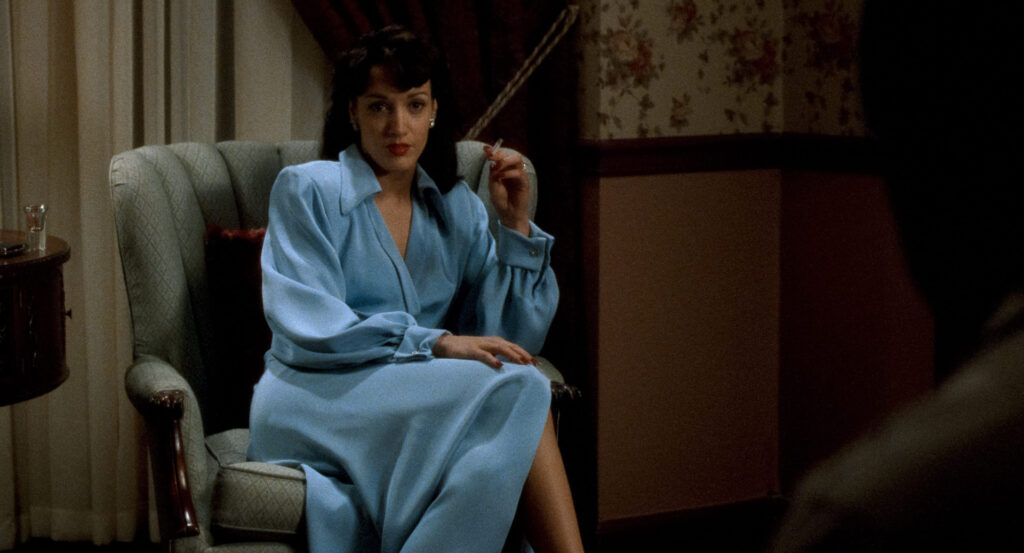
Devil in a Blue Dress marked her first time as a full costume designer working with Denzel Washington. She wasn’t in the guild. She had no formal training. But she had the vision.
“I was concerned I would be fired in two weeks because I had never done anything on this scale,” she said. “So I really had to do a lot of research. I had to find little trinkets of each character I could bring something special to.”
She did more than that. She told the story of a man trying to survive in 1940s LA and she did it with subtlety, intention and a coat that still sticks with her.
“We had a story about his coat. He wore it as a safeguard. If he wore a jacket from the factory he worked at, he thought he wouldn’t be targeted,” she said. “So we did it. I worked more like an actor than a designer on that film.”
And then came Django. Bold. Bloody. Explosive. Davis sat in Tarantino’s private theater waiting for him to arrive. The “interview” turned out to be a quiz show on Black exploitation films and her knowledge of spaghetti westerns.
She passed. She got the job.
And she got to build one of the most iconic costumes in modern cinema, that powder blue suit.
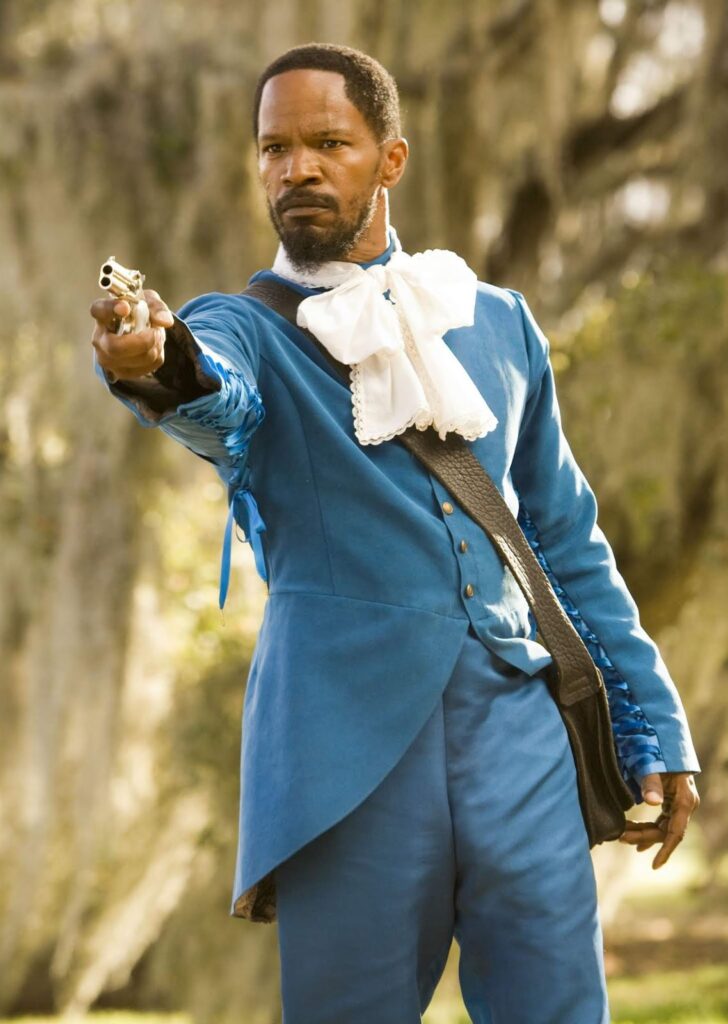
“Everyone knows it’s the Blue Boy from the painting,” she said. “The script called for a powder blue ballet suit and I thought, I’m gonna take a shot at this. He couldn’t have the Blue Boy. And Quentin loved it.”

But iconic doesn’t mean easy. Davis had to source vintage silk faille in a color no one made anymore, then hand-dye it over and over.
She needed at least ten versions for all the blood, stunts and takes. It wasn’t just style.
This was logistics.
It was storytelling. It was war.
And as always, color meant something.
“Kerry Washington’s character — before we see her, Django is dreaming about her. So her colors were vivid and jewel-toned, like a fantasy,” Davis explained. “But when we finally see her, she’s in black and gray. Because that was her reality. She was enslaved. She was imprisoned.”
That contrast, that heartbreak, was by design. Her clothes told the story before a single word was spoken. And that’s the point.
The Climb: How Sharen Davis Changed the Game From Behind the Seams
By the time Sharen Davis was standing on the Academy Awards red carpet, she still wasn’t sure how she got there. Not because she didn’t deserve it but because she was too busy working. Too busy making magic. Too busy saying yes and figuring it out later.
“We were just happy it was done,” she said, talking about Ray. “I thought Jamie would be nominated. I didn’t think I’d done some heavy creative look. I just told the story.”
She told it so well she got her first Oscar nomination.
For over 100 looks, researched by hand, sewn with purpose and grounded in Ray Charles’s real life. It wasn’t about glitz.
This was about honoring the man behind the music and the people who had never gotten the Hollywood treatment before.

That became a pattern. After Ray came Dreamgirls, The Pursuit of Happyness, The Help, Django, Fences. Projects that didn’t just pay well. Projects that meant something. Projects where a Black woman behind the camera could pour her soul into the work.
And with that came responsibility. Davis wasn’t just costuming characters. She was building visual memory. And the way she did it wasn’t through ego or entitlement. It was through care.
“It’s not exactly comfortable, per se, as in comfortable clothing,” she said. “It’s comfortable that the costume is not wearing them. That they feel like they are this character.”
Which is exactly what made asking her a question such a powerful thing. I wasn’t just interviewing a costume designer. I was speaking to a woman who has shaped how Blackness is remembered on screen.
So I asked her, as directly as I could:
How do you balance historical accuracy with cultural nuance when you’re telling stories through a Black lens in a white-dominated Hollywood?
Her answer, exclusively to Hollywoodland News, was simple but it held everything.
“I will use my imagination and my pride to not lower or, you know, I will enhance a look because of pride and dignity. I just don’t feel it’s necessary to make someone dirty or torn up when they’re in that. It’s not really called for. There’s a way you can portray someone struggling with all of that, especially when it comes to black lives. I don’t want to do that.”
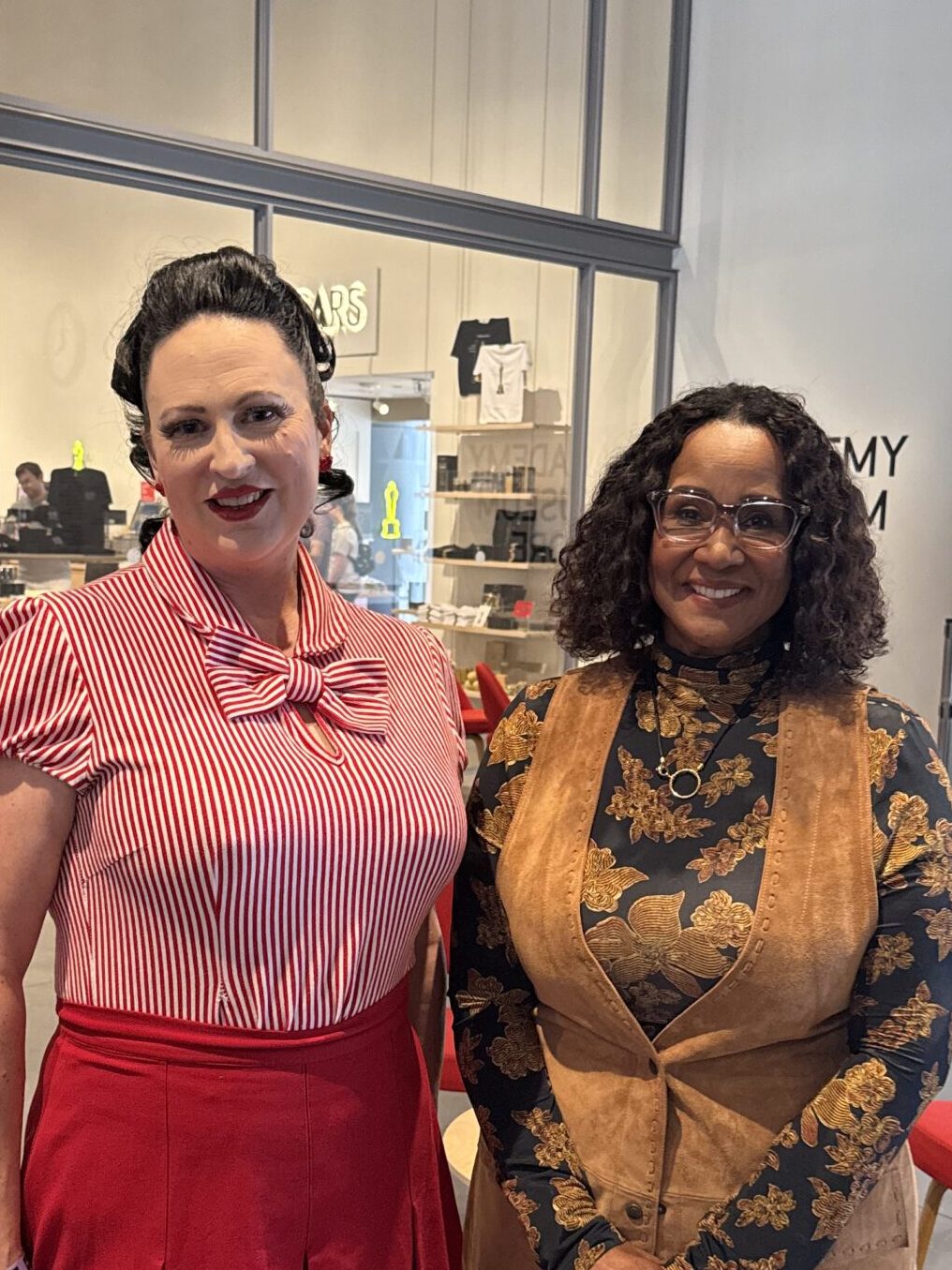
That’s the thread running through all of it. Pride. Memory. Dignity.
Whether it’s a blue suit in a Tarantino western or a pair of church shoes in The Help, Sharen Davis isn’t dressing characters.
She’s dressing generations.
The fact that she’s still here, still working, still answering questions from people like me, people who see what she’s doing, is proof that the work matters.
Legacy in Motion: The Quiet Power of Sharen Davis
Sharen Davis didn’t come to Hollywood with a plan. She came with instinct, memory and a work ethic that never quit. She took care of every detail, protected every character, and held the line for every story that deserved to be told with care. And somewhere along the way, without asking for the spotlight, she became a legend.
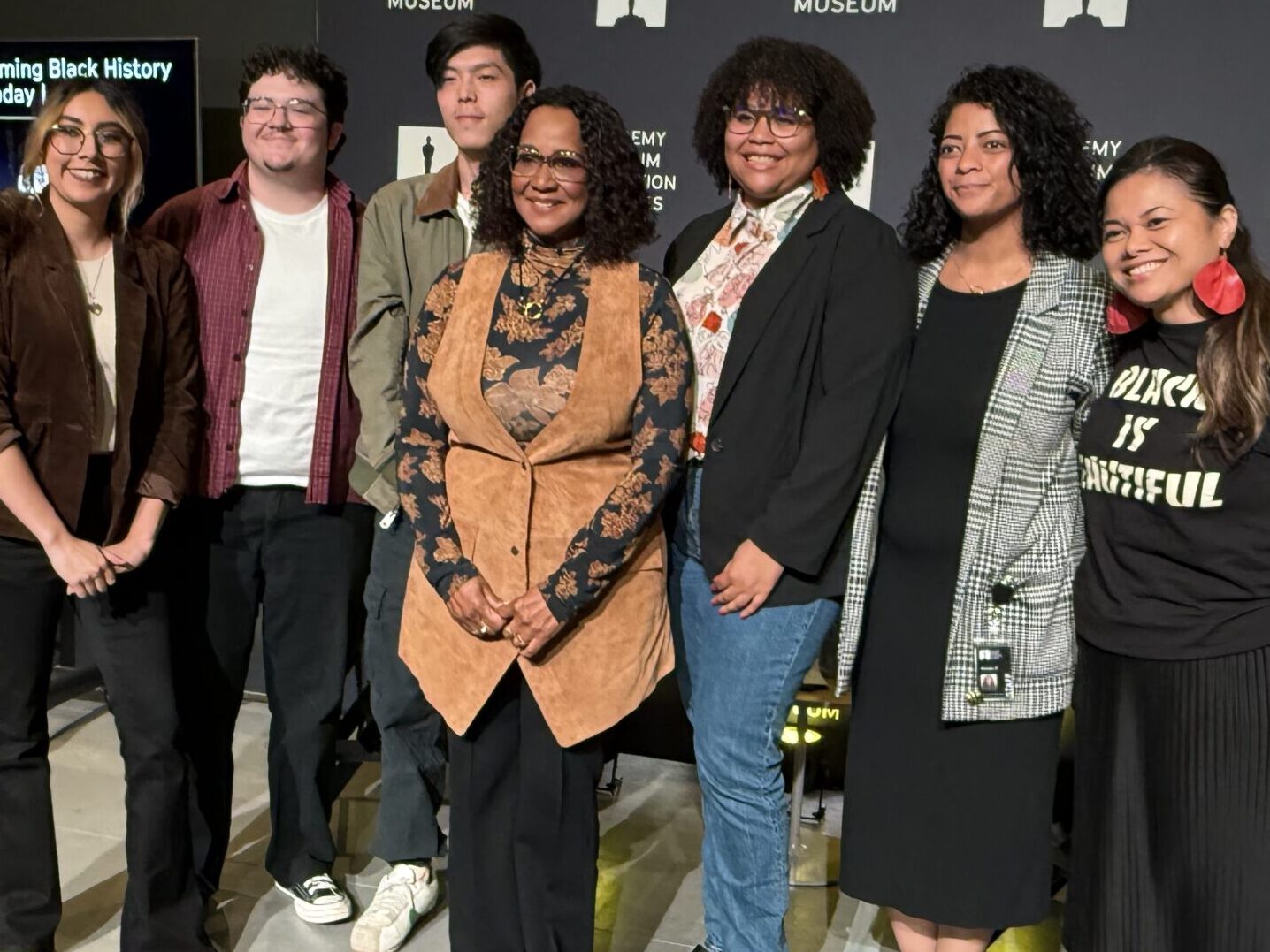
She doesn’t always talk about it like that. She talks about getting the job done. About making sure her crew is paid. About making sure actors feel like themselves when they walk on set in someone else’s skin.
“I really get into it,” she said. “I love when I see them upset and the costume is making them work. They’re not fussing with it. They’re just really into their character.”
That’s what Sharen creates, not just a costume, but an entry point into becoming someone else. She sees actors not as mannequins, but as people who need to move, feel, and breathe inside the story.
Even when the story is messy. Especially when the story is true.
“Life’s not always clean. Sometimes it’s messy,” she said. “So it’s important to have those stories told too.”
And when asked about advice, the kind of wisdom you don’t get in film school, she didn’t talk about connections or name-dropping. She talked about something much harder and more radical.
“Keep your cool,” she said. “It’s just not worth it. There are so many different personalities. Creative personalities. You really got to go above that.”
Because staying calm in chaos is how you survive. How you build. How you stay in the room long enough to change it.
And she has.
Sharen Davis has made history visible, not in textbooks or museums, but on screens big and small. She’s dressed freedom fighters, doo-wop queens, domestics and revolutionaries. She’s done it all from behind the seams.
So when we talk about legacy, when we talk about impact, when we talk about what it means to be a Black woman in Hollywood creating with purpose, let’s talk about Sharen Davis.
And let’s say her name like the icon she is.
If you want to understand the depth of Sharen Davis’s work, don’t just read about it. Go see it. Her designs are on display now at the Academy Museum of Motion Pictures, including the iconic powder blue suit from Django Unchained. Stand in front of it. Take in the details. Remember that every stitch was intentional. Every fabric choice meant something. Every look carries a story.
Because legacy doesn’t just live on screen. Sometimes it’s right there in the seams and you can see it for yourself.
Visit AcademyMuseum.org for tickets and exhibit info.

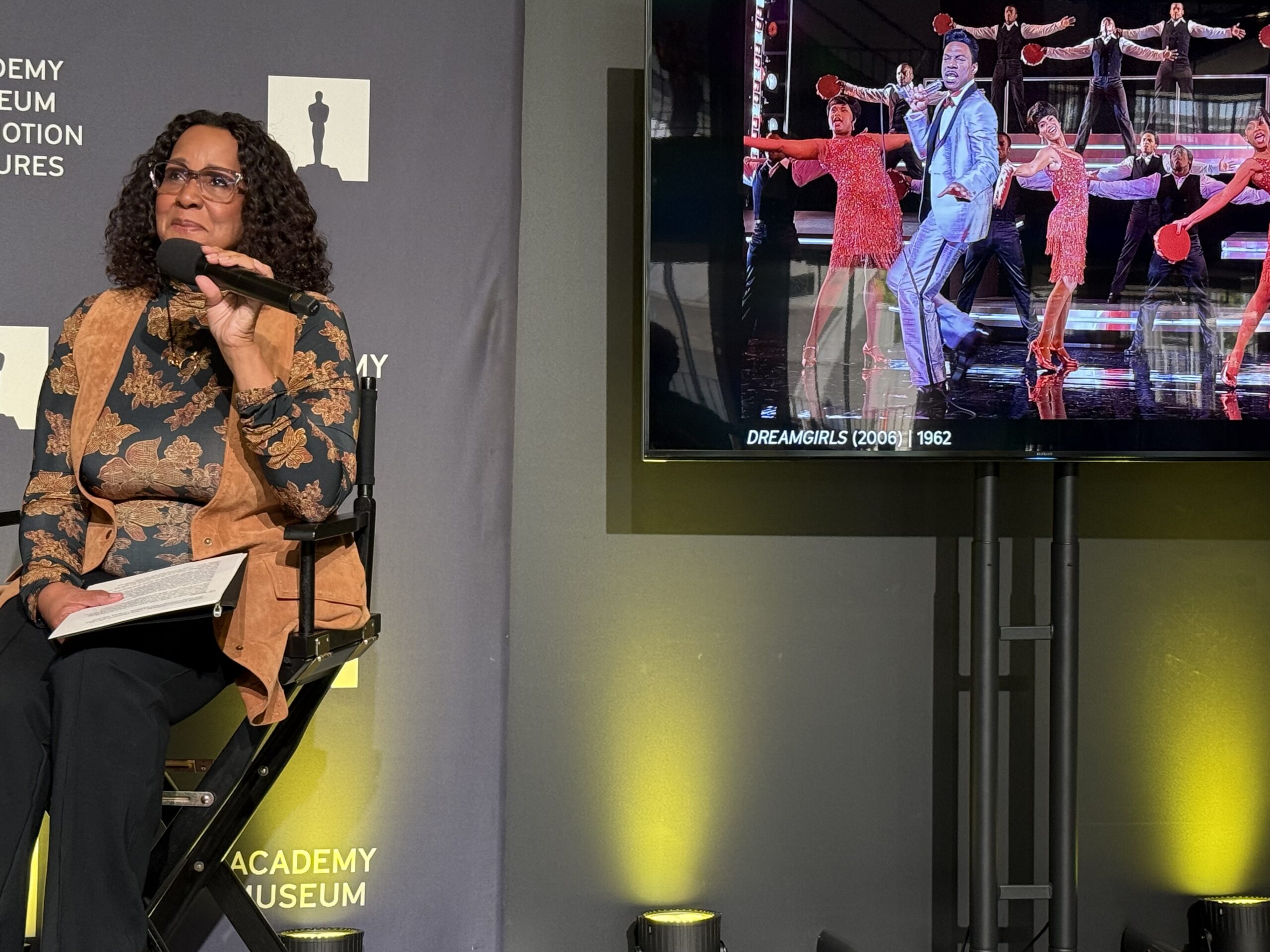
Leave a Reply